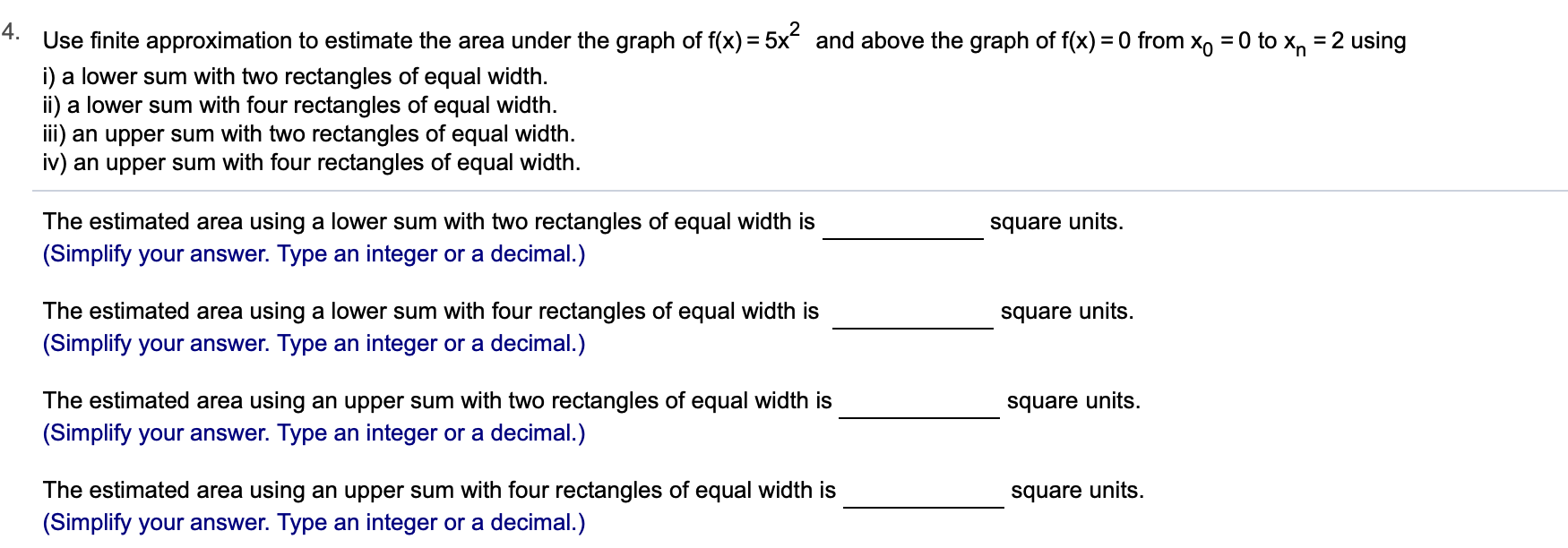4. Use finite approximation to estimate the area under the graph of f(x) 5x i) a lower sum with two rectangles of equal width ii) a lower sum with four rectangles of equal width i) an upper sum with two rectangles of equal width. iv) an upper sum with four rectangles of equal width and above the graph of f(x) 0 from Xo = 0 to x, = 2 using The estimated area using a lower sum with two rectangles of equal width is (Simplify your answer. Type an integer or a decimal.) square units The estimated area using a lower sum with four rectangles of equal width is square units (Simplify your answer. Type an integer or a decimal.) The estimated area using an upper sum with two rectangles of equal width is square units (Simplify your answer. Type an integer or a decimal.) The estimated area using an upper sum with four rectangles of equal width is (Simplify your answer. Type an integer or a decimal.) square units
4. Use finite approximation to estimate the area under the graph of f(x) 5x i) a lower sum with two rectangles of equal width ii) a lower sum with four rectangles of equal width i) an upper sum with two rectangles of equal width. iv) an upper sum with four rectangles of equal width and above the graph of f(x) 0 from Xo = 0 to x, = 2 using The estimated area using a lower sum with two rectangles of equal width is (Simplify your answer. Type an integer or a decimal.) square units The estimated area using a lower sum with four rectangles of equal width is square units (Simplify your answer. Type an integer or a decimal.) The estimated area using an upper sum with two rectangles of equal width is square units (Simplify your answer. Type an integer or a decimal.) The estimated area using an upper sum with four rectangles of equal width is (Simplify your answer. Type an integer or a decimal.) square units
Functions and Change: A Modeling Approach to College Algebra (MindTap Course List)
6th Edition
ISBN:9781337111348
Author:Bruce Crauder, Benny Evans, Alan Noell
Publisher:Bruce Crauder, Benny Evans, Alan Noell
ChapterA: Appendix
SectionA.2: Geometric Constructions
Problem 10P: A soda can has a volume of 25 cubic inches. Let x denote its radius and h its height, both in...
Related questions
Topic Video
Question
Can i get help step by step with this problem please

Transcribed Image Text:4.
Use finite approximation to estimate the area under the graph of f(x) 5x
i) a lower sum with two rectangles of equal width
ii) a lower sum with four rectangles of equal width
i) an upper sum with two rectangles of equal width.
iv) an upper sum with four rectangles of equal width
and above the graph of f(x) 0 from Xo = 0 to x, = 2 using
The estimated area using a lower sum with two rectangles of equal width is
(Simplify your answer. Type an integer or a decimal.)
square units
The estimated area using a lower sum with four rectangles of equal width is
square units
(Simplify your answer. Type an integer or a decimal.)
The estimated area using an upper sum with two rectangles of equal width is
square units
(Simplify your answer. Type an integer or a decimal.)
The estimated area using an upper sum with four rectangles of equal width is
(Simplify your answer. Type an integer or a decimal.)
square units
Expert Solution
This question has been solved!
Explore an expertly crafted, step-by-step solution for a thorough understanding of key concepts.
This is a popular solution!
Trending now
This is a popular solution!
Step by step
Solved in 4 steps with 4 images

Knowledge Booster
Learn more about
Need a deep-dive on the concept behind this application? Look no further. Learn more about this topic, calculus and related others by exploring similar questions and additional content below.Recommended textbooks for you

Functions and Change: A Modeling Approach to Coll…
Algebra
ISBN:
9781337111348
Author:
Bruce Crauder, Benny Evans, Alan Noell
Publisher:
Cengage Learning

Algebra & Trigonometry with Analytic Geometry
Algebra
ISBN:
9781133382119
Author:
Swokowski
Publisher:
Cengage

Mathematics For Machine Technology
Advanced Math
ISBN:
9781337798310
Author:
Peterson, John.
Publisher:
Cengage Learning,

Functions and Change: A Modeling Approach to Coll…
Algebra
ISBN:
9781337111348
Author:
Bruce Crauder, Benny Evans, Alan Noell
Publisher:
Cengage Learning

Algebra & Trigonometry with Analytic Geometry
Algebra
ISBN:
9781133382119
Author:
Swokowski
Publisher:
Cengage

Mathematics For Machine Technology
Advanced Math
ISBN:
9781337798310
Author:
Peterson, John.
Publisher:
Cengage Learning,